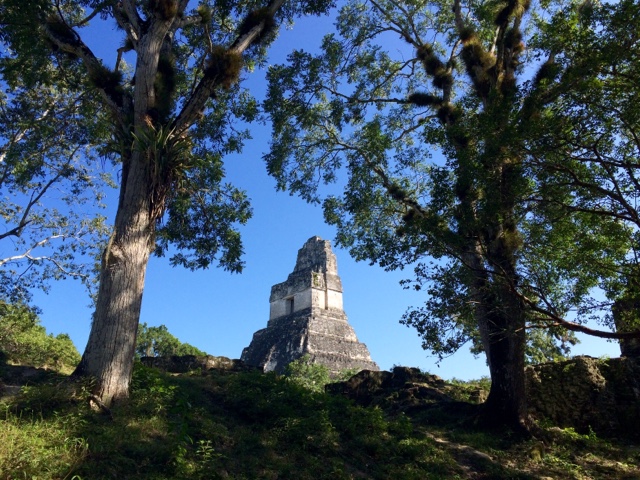Tik'al, a name which means 'the place of voices' has a rich history which spans nearly 1800 years from its creation in 900 b.c.e. until its abandonment around 840 c.e. The original name of the city-state was Mutul and the location was home to nearly 200.000 citizens. The city was built surrounded by swamps as a means of defense from invaders and the entire location had remained a mystery until its rediscovery in the 1800's. To this day only about 20% of the site has been excavated whereas the jungle has completely overtaken the ancient buildings.

We showed up to Tik'al at 4am under the veil of a starlit sky which I made no effort to photograph. The sun rose over the ancient temples to reveal that the equinox approaches soon and such phenomena are laden in the secrets beheld in this amazing location.

Every step and every layer of the temples contains purpose. The average lifespan of a Mayan was about 52 years and according to popular belief the temples were built upon every 52 years, none of them are hollow yet they contain multiple layers added to over hundreds of years.
The temples were not used for burials much like the pyramids of ancient Egypt. They were accessed by only priests and high ranking leaders. Interestingly the people who were given higher status and were fed the best foods and bred with the finest women. Their lineage created taller people who lived to be over 80. The steps were noticeably higher and they were never to be accessed by the common folk. Priests entered temples to communicate wth the gods and although the practice of human sacrifice was very real it was never practiced on the tops of temples but rather on circular altars in front. Heads were never tossed down the stairs as we've seen in movies and literature, there is no evidence of this ever happening.


Nature reclaiming a temple.

Optimus Prime?

The history of Tik'al/the people of Mutul has been gathered on the sides of stelae in the form of hieroglyph. Much of what we have learned about the ancient Mayans is collected from these stones however it is important to understand the Mayans were not an empire but rather various groups of similar culture and tradition. Tik'al had been attacked relentlessly in 300 c.e. and its inhabitants have come from various linguistic backgrounds.



Various stelae showing human sacrifice can be found in front of dozens of circular alters. Touching them will give you the chills as many people lost their lives on these stones.



Sacrificial alter.



From the temple of the queen, across from the temple of her husband where they now rest in eternity in the depths of Xibalba, the Mayan underworld. Their temples are located in the central plaza which hosts a residential zone (never verified if these were homes for the wealthy elite or guest houses for visitors to ceremonies) and a necropolis to the other direction where over 180 tombs have been discovered all belonging to kings, queens and holy people.

A little climbing and ignoring of 'no climbing' signs can reveal a great rooftop view from the residential zones.

Temple I, the famous view of Tik'al with various sacrificial alters found below. The center is a firepit still used by Mayan priests today although chickens are sacrificed instead of humans.



Lara Croft :)

During the Equinox or solstice there is a phenomenon where a single beam of light will be cast from the temple into this small window. This shows that it is time to plant or harvest.












The necropolis holds about 180 tombs but many are still undiscovered. It's amazing to walk through the outskirts of the site and know that potentially hundreds of bodies still remain in the dirt below you. As most of Tik'al has not been excavated it is very interesting to see the various temple-shaped hills which remain, so much history remains untold.



You can plainly see how much of the temples remain underground in this photo. There is a great lack of funding to support such projects.

What secrets hide inside this hill?













The irony of Tik'al is that while its location was chosen out of natural abundance it was inevitably the deforestation of the area which likely lead to its abandonment. When there are no trees there is no rain and of course no rain means no food. There is a lesson to be taken from the story of the Mayans in their abrupt disappearance.






Beautiful
ReplyDeletefascinating anecdotes :)
ReplyDelete